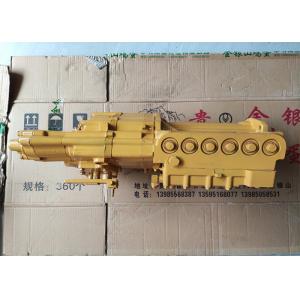
Add to Cart
3306 Used Fuel Injection Pump For Excavator E330B 149 - 9851
Specification
| Part name | Engine fuel pump |
| Pump code | 149 - 9851 |
| Pump number | 153 - 5739 |
| Condition | Original Used |
| Test staus | Normal |
| Engine Type | Diesel |
| Injection | Direct injection |
| Quality | High quality |
Description
Definition of Inline Injection Pump
Fuel feeds are fuel enter-exit door, there are three fuel feeds
inlet feed, used as fuel entrance from the tank to the pump
output feed, used as the fuel exit to the injector in high pressure conditions
return feed, used to drain the remaining fuel that is not pressed into the injector
And how does it work?
1. The outside mechanism of injection pump
Generally, there is a mini pump that is used to transfer fuel from the tank into the injection pump. This pump works mechanically, meaning it is driven by the crankshaft engine.
So, to run the fuel flow we need to crank the engine.
When the crankshaft rotates, the mini pump will send diesel fuel from the tank into the injection pump through the inlet feed. From the inlet feed, the fuel directly fill the fuel barrel and it is ready to be pressed.
2. The injection pump mechanism
The pump camshaft is connected to the engine crankshaft, so that when the engine cranks automatically the pump camshaft rotates.
This rotation will move the plunger, so that the plunger is pressed upwards and as a result the fuel that is already in the fuel barrel is pressed with high pressure and enters the injector.
When the cam has finished pressing the plunger, the plunger returns to the bottom position. This will reopen the fuel barrel chamber, so that the fuel from the inlet feed filling the fuel barrel directly.
3. Engine RPM setting mechanism
To adjust engine RPM on conventional diesel, it is done by adjusting the amount of fuel injected by the injector.
In this case, the control is located in the fuel barrel. How much the amount of fuel in the fuel barrel when it is pressed will affect the engine RPM.
it is the task of rack and pinion. These two components will regulate the amount of fuel in the fuel barrel by regulating fuel disposal through the return feed.
The amount of fule is less (Low RPM)
The amount of fuel is more (high RPM)
So, there is a fuel path inte plunger from the fuel barrel leading to the return feed.
This path is made with a certain slope, so that when the angle of the plunger is rotated, it will affect the amount of fuel contained in the fuel barrel
To be clearer you can see the picture (viewed from side)
a. when low RPM
The amount of pressed fuel is lower, so the angle of plunger can be seen from the picture.
2. when high RPM
The amount of pressed fuel is more, so the angle of plunger can be seen from the picture.

